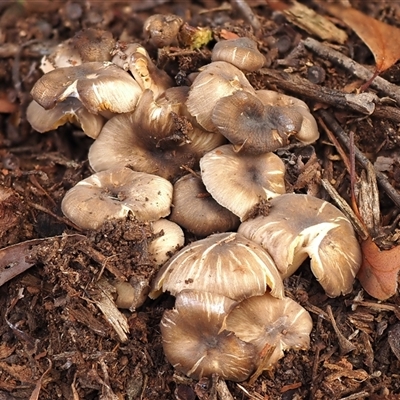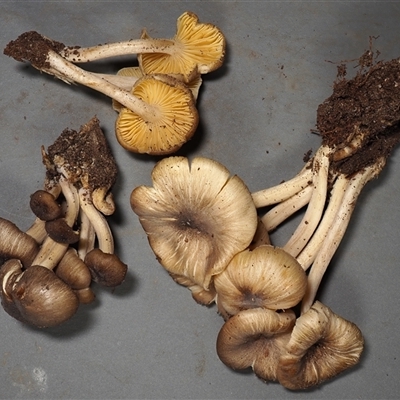Trogia subglobospora ‘yellow gills’
The fruitbody is a mushroom with a cap atop a central stem. The caps are up to 30 millimetres in diameter and at maturity are a little funnel shaped (but start off convex). Initially they are very dark brown but later light brown to buff except for a darker centre – and some darker brown radial streaks. The cap is dry and bears radially aligned, brown fibrils and some tiny scales (more obvious in younger caps). The gills are yellowish white to creamy yellow and run slightly down the stem. The stem is off-white and may be up to 50 millimetres long and 5 wide.
There is neither a partial nor a universal veil.
Spore print: white
The mushrooms grow in a cluster on the ground (but very likely arise from buried wood).
Look-alikes
The combination of ALL the features noted above should make this fungus distinctive.
Technical note: Isn’t this Trogia subglobospora var. mellea?
In 1966 Corner published a description of Trogia subglobospora (with whiteish gills), based on material collected in Borneo. In his 1991 work he noted further collections of this species from the Solomon Islands and also recorded a yellow-gilled variety as Trogia subglobospora var. mellea- also from Borneo and the Solomon Islands. On the Queensland mycological society website you find a page headed Trogia subglobospora var. mellea (https://qldfungi.org.au/wp-content/uploads/2014/06/Trogia-subglobospora-var-mellea.pdf) with a note that the Queensland specimens agree in almost all respects with Corner’s mellea. Specimens collected at the ANBG (April 2023) may well be the same as the Queensland species and also have a reasonable agreement with Corner’s mellea. However, he described the spores (in both the white and yellow gilled forms) as ‘pale violaceous amyloid’, whereas the ANBG specimens showed no amyloid reaction (and, interestingly, no amyloid reaction is mentioned on the Queensland page). Therefore it is possible that any such Trogia found in the local region, while akin to subglobospora, is neither of Corner’s taxa – hence the ‘yellow gills’ qualifier. The Trogia-like fungi of Australia are not well-studied.
The tissue in the ANBG specimens contains ‘standard’ hyphae but also numerous long cells that become quite wide but narrow greatly towards each end (hence they are spindle-like or fusiform). Corner named this sort of tissue construction sarcodimitic and this (or sarcotrimitic construction – with three forms of hyphae) is a feature of his concept of Trogia.
References
E.J.H. Corner (1966), A monograph of cantharelloid fungi, Oxford University Press.
E.J.H. Corner (1991), Trogia (Basidiomycetes),National Parks Board, Singapore Botanic Gardens (=The Gardens’ Bulletin Singapore Supplement No. 2).
Trogia subglobospora ‘yellow gills’ is listed in the following regions:
Canberra & Southern Tablelands
Species information
- Trogia subglobospora ‘yellow gills’ Scientific name
- Common name
- Not Sensitive
- Cosmopolitan
- Unknown
- Machine learning
Location information
-
Maps
ANBG -
Places
Acton, ACT






